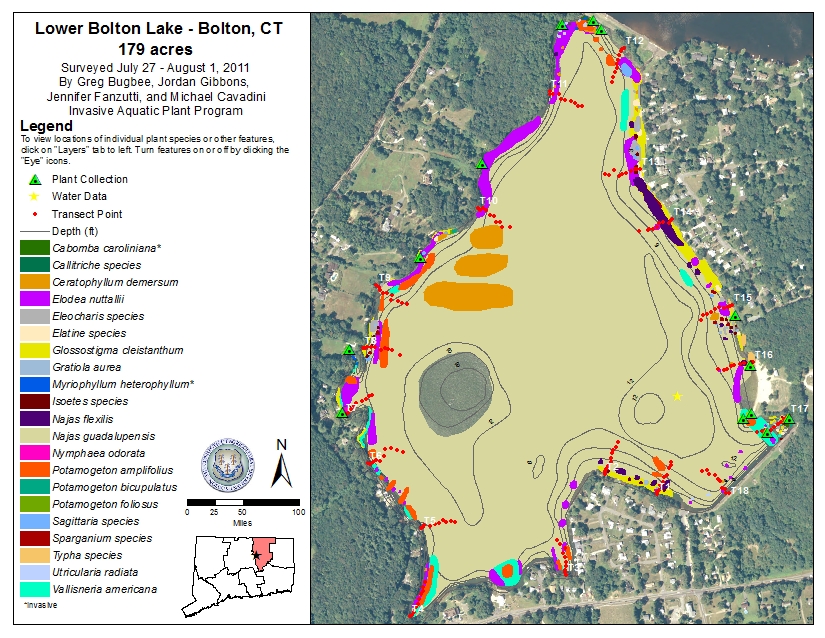Lower Bolton Lake, Bolton - 2011
Lower Bolton Lake is a 179-acre waterbody with substantial residential development near its shoreline. The maximum depth is 20 feet and the mean depth is 11 feet. There is a town beach and a state-operated boat launch on the southeastern shore. The lake has a dam on its northern end, bordering Middle Bolton Lake, and a dam along the southeastern shore where the lake’s water drains over a causeway.There are a few hiking trails along the northern shore for recreational use.
Lower Bolton Lake was previously surveyed by CAES IAPP in 2005. The 2005 survey found sparse vegetation and the presence of one invasive, variable-leaf watermilfoil (Myriophyllum heterophyllum).Our 2011 survey found two invasives: variable-leaf watermilfoil and fanwort (Cabomba caroliniana).They were found growing together in small patches near the dam and in a small narrow cove along the western shore. Fanwort was also found growing in the southeast shore near the causeway. Because fanwort is a new infestation that occurs in a limited area hand removal could prevent a future large infestation.
Nineteen native species were found in 2011 compared to 15 in 2005. Vegetation grew along the majority of the shoreline. Eight native plants were present in water less than one meter deep: water starwort (Callitriche species), waterwort (Elatine species), spikerush (Eleocharis species), mudmat (Glossostigma cleistanthum), golden hedge-hyssop (Gratiola aurea), quillwort (Isoetes species), arrowhead (Sagittaria species), and bur-reed (Sparganium species). Mudmat was most dominant, especially along the eastern shore. Other natives that grew from the shoreline to greater than a meter depth included: coontail (Ceratophyllum demersum), western waterweed (Elodea nuttallii), slender naiad (Najas flexilis), southern naiad (Najas guadalupensis), large-leaf pondweed (Potamogeton amplifolius), snailseed pondweed (Potamogeton bicupulatus), leafy pondweed (Potamogeton foliosus), floating bladderwort (Utricularia radiata), and eelgrass (Vallisneria americana). One floating plant was found, white water lily (Nymphaea odorata).
The most dominant plant in Lower Bolton Lake was southern naiad.It was found growing almost everywhere where the water was less than five meters.Patches became denser when the water depth became greater than two meters.Frequently, the plant grew by itself but western waterweed could be found growing with it as well.In shallower water, thesouthern naiadcould still be found but generally it was less dense.Along 18 transects totaling 180 points, southern naiadwas found at 153 of those points (85%). Southern naiad was not present in our 2005 survey and has now become a nuisance. It possible this apparently aggressive form of southern naiad is actually a hybrid.
|
Species recorded in our 2011 survey of Lower Bolton Lake. |
||
| Arrowhead |
Golden hedge-hyssop |
Southern naiad |
| Bur-Reed |
Large-Leaf pondweed |
Spikerush |
| Cattail |
Leafy pondweed |
Variable-Leaf watermilfoil* |
| Coontail |
Mudmat |
Water starwort |
| Eelgrass |
Quillwort |
Waterwort |
| Fanwort* |
Slender naiad |
Western waterweed |
| Floating bladderwort |
Snailseed pondweed |
White water lily |



